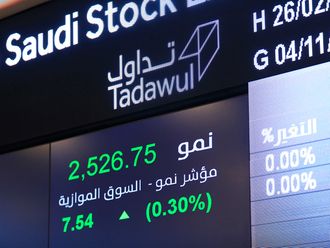
LONDON: Brent crude hit a new four-year low on Wednesday before recovering to just under $85 a barrel, as faltering global growth curbed demand for fuel at a time of heavy oversupply.
Oil saw its biggest daily fall in more than three years on Tuesday after the West’s energy watchdog slashed its forecasts for world oil demand for this year and 2015.
Brent for November delivery touched a fresh post-2010 low of $83.37, down $1.67, before recovering to around $84.80 by 1330 GMT. Brent has now fallen more than 25 per cent from the year’s mid-June peak.
US crude fell 24 cents a barrel to $80.61 after hitting a new 27-month low of $80.01 on Wednesday. On Tuesday, the contract posted its largest fall in a single session in nearly two years.
Traders said prices had rebounded slightly after US crude held above $80 a barrel, a symbolically important level in a market that has crashed through most lines of major support.
But prices remain under pressure as core members of the Organisation of the Petroleum Exporting Countries appear to be focused on fighting for market share rather than on cutting production to shore up prices.
Weak European markets and slowing Chinese inflation added to concerns about global growth, which have helped extend the rout.
“The global environment is bearish,” said market analyst Olivier Jakob of Petromatrix. “There’s broad acceptance by the market that Saudi Arabia is willing to let prices go lower. With the velocity of the drop, definitely you’ve got people liquidating positions.” US economic data was mixed, producer prices fell for the first time in more than a year — a sign that energy demand could be boosted by lower prices — but retail sales fell.
Dealers said technical selling was coming into play, with Wall Street banks scrambling to neutralise exposure to big oil option trades, but the main pressure came from burgeoning global oversupply.
“For as long as Opec makes no move to tackle this threat of a massive oversupply by reducing production, prices are likely to continue to fall,” Commerzbank said in a report. “Opec producers cannot hope for any reduction in shale oil production in the US in the near future.” Data from the United States suggests no eminent slowing of the boom in shale oil production.
US shale oil production is set to grow by around 106,000 barrels per day in November from October, the US Energy Information Administration said.
On Tuesday, Iran said it could live with lower oil prices, joining the chorus of similar signals from core Opec members Saudi Arabia and Kuwait.
US commercial crude oil inventories were forecast to have increased in the week ended October 10, while refined products likely fell, according to a Reuters poll of analysts.
Industry group the American Petroleum Institute (API) will issue its report later on Wednesday, and the EIA will follow with its weekly data on Thursday. The reports have been delayed a day due to Monday’s Columbus Day holiday.












